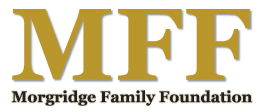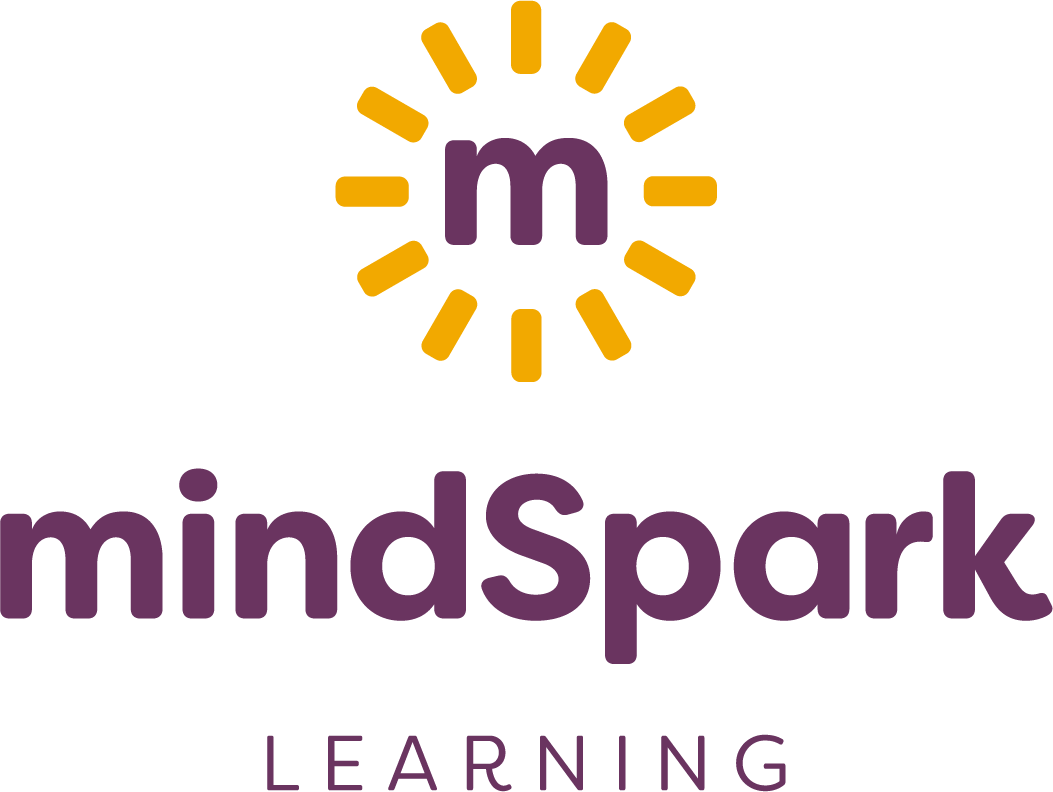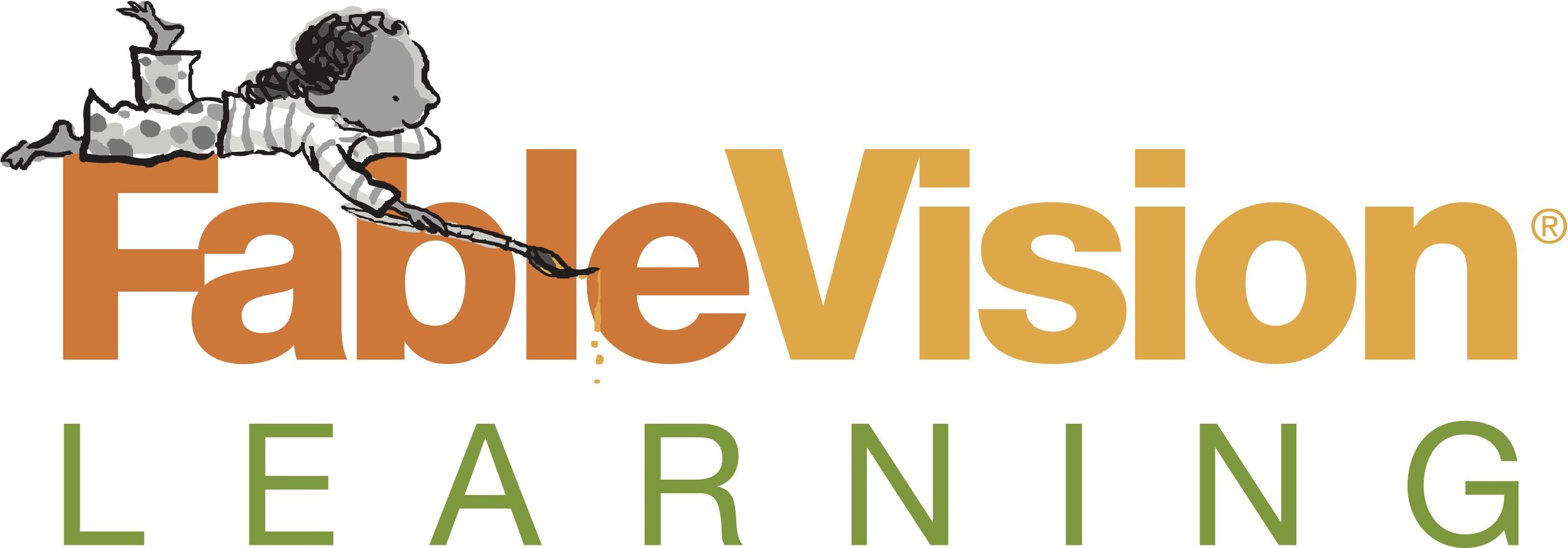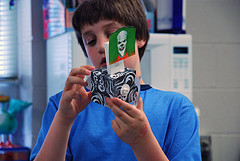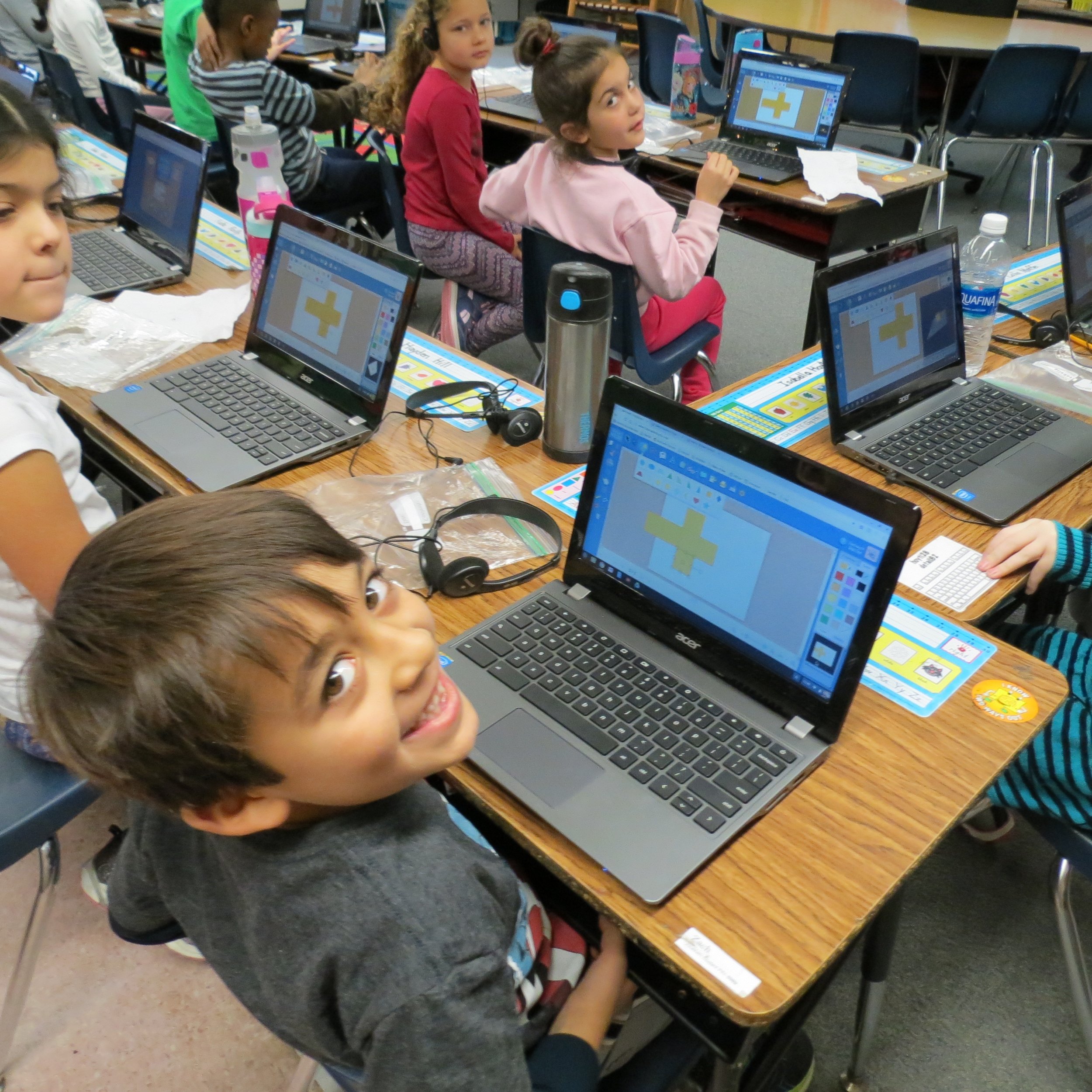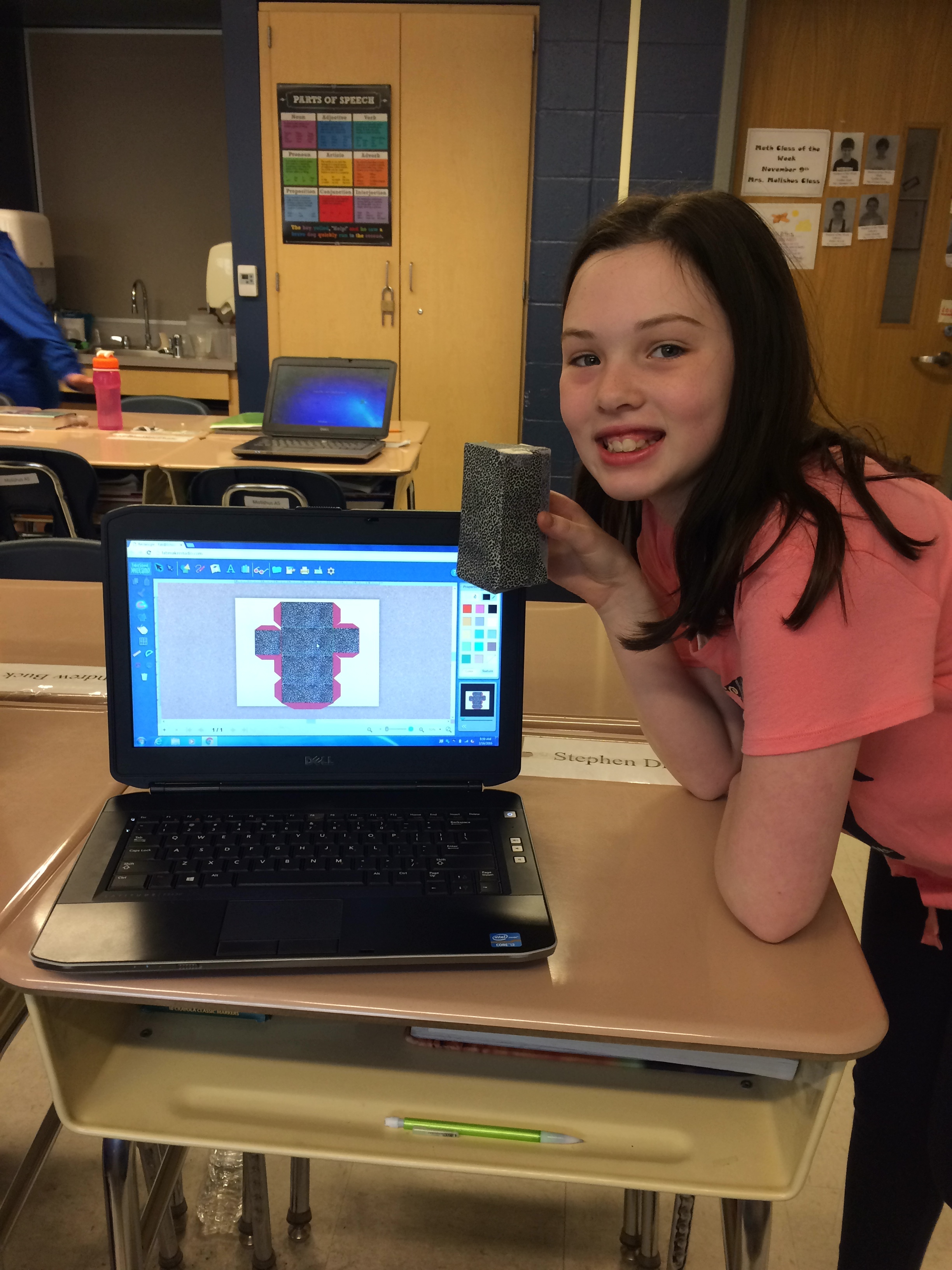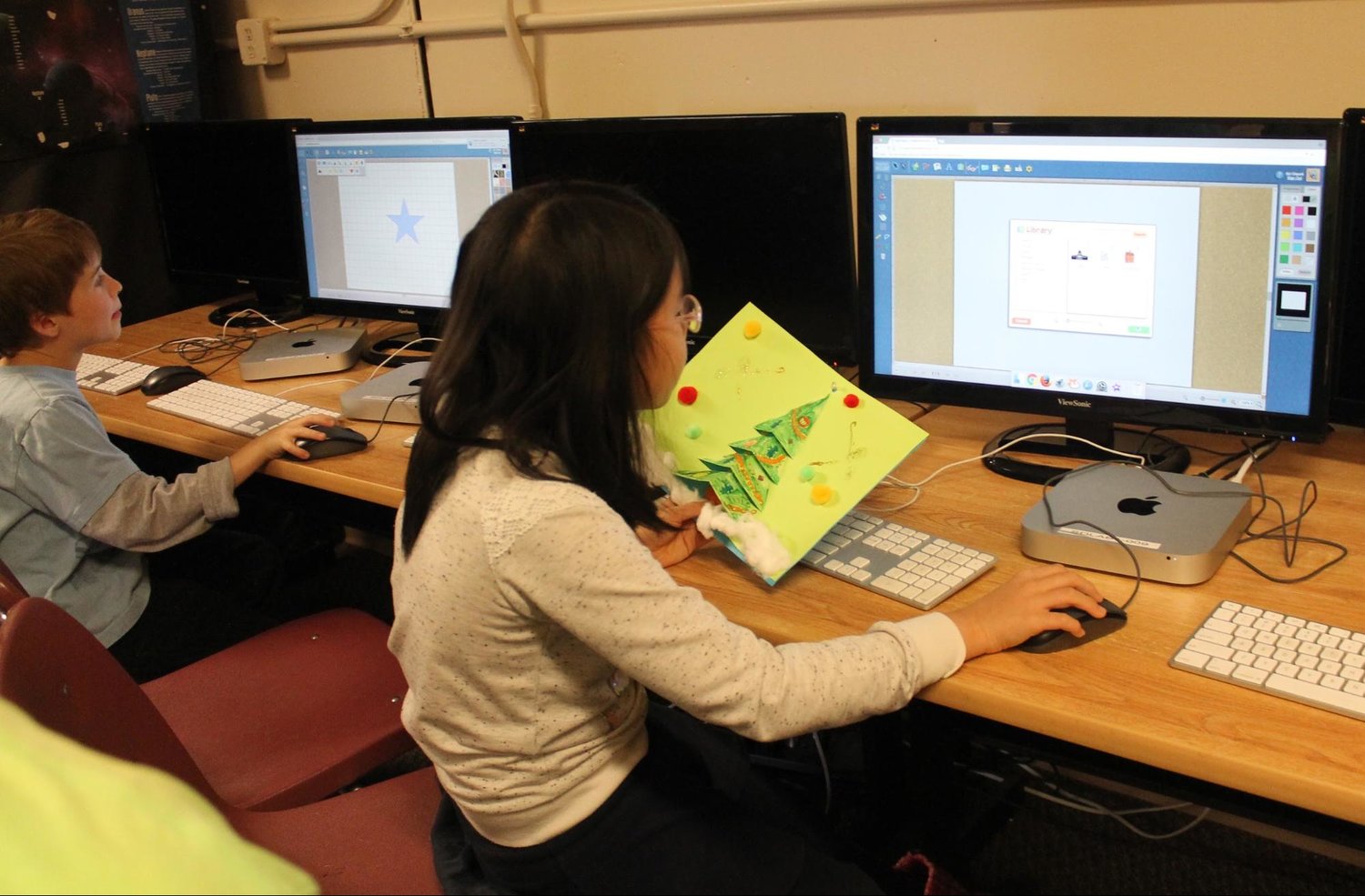FableVision Learning Spotlight Blog
Categories
- Animation-ish 42
- Books 21
- Civics! 2
- Classroom Spotlight 17
- Conferences and Events 20
- Creative Educator 3
- Creativity 25
- Distance Learning 13
- Dot Day 22
- FabClassroom 28
- FabFriday 19
- FabMaker Studio 66
- FabMaker Studio Classroom 13
- FableFive 7
- FableVision Games 3
- Free Educator Resources 36
- HUTCH 1
- Home Activities 5
- In the Classroom 34
- In the News 11
- International Dot Day 23
- Ish 1
- Library 1
- Mapping the World by Heart 7
- Paul Reynolds 10
- Peter H. Reynolds 54
- Professional Development 9
- STEM/STEAM 20
- Storybook Academy 2
- Teacher Spotlight 14
- The Dot 17
- The North Star 2
- Words and Their Stories 1
- Zoombinis 3
FabMaker Spotlight: Combining 3D forms with Warm/Cool Colors
By creating 3D shapes in FabMaker Studio that also supported an LED light and battery, students at Farmington High School in New Hampshire explored design while creating a 3D self portrait.
Shannon McCracken shared about the process:
“I wanted to ‘up the level’ a little so I also had students plan a hole for an LED and a battery to be attached to it, so the forms would glow from the inside. Most students picked up the Fab Maker program and Silhouette hardware very easily. Once they mastered it I had them show someone else and so on and so forth. The students had a good time and I made most of them create their own shapes, from scratch, so they had to practice how things bent and twisted before going onto the FabMaker.”
Is your classroom a FabClassroom? We would love to highlight your school! To be featured in an upcoming post, send an email to andrea@reynoldstlc.org. You can also tweet your photos with the hashtag #FabMakerStudio! For more posts featuring FabMaker Studio, click here.
FABClassroom: Physics Club Engineers Solution to Safely Land Lizard
Located in the beautiful Sonoran Desert of Yuma, Arizona, Centennial Middle School is surrounded by colorful sunsets, warm winters and inspiring educators.
Science teacher Kaitlin McGill has been using FabMaker Studio with her Physics Club. She recently shared a bit about the parachute project that required her students to collaborate and design a parachute that can safely land a small plastic lizard on the ground.
How did you pose the parachute challenge to the students? Were there specific parameters?
I introduced them to Newton’s Laws of Motion. We favored the law “An object in motion stays in motion, unless an outside force acts on it”. So, I challenged them with the following: Create a parachute or something that will safely land a small plastic lizard to the ground.
What has been design process on the parachutes?
We have been following the engineering design process.
Problem: Safely get the little plastic lizard to the ground.
Background Research: Students used their iPads to look up what a parachute is and what various parachutes look like. Also, Newton’s Laws of Motion and principals of aerodynamics.
Specify Requirements: Students learned that they needed a parachute that is big enough to support the weight of the small lizard.
Develop and Prototype Solutions: Students made several prototypes, approximately ten. When it did not work, they went back to the drawing board and modified their designs in FabMaker Studio.
Test solutions: Students stood on a step stool or ladder to test the accuracy of their design.
Solutions Met Requirements: Students met the requirement after six weeks of failed attempts.
Communicate the Results: The students discussed why their parachute attempts failed or were successful.
What has been one “aha” moment working with students with Fab@School?
There would be times when the students would feel frustrated with their failing design. They learned that working collaboratively, instead of individually, can create a better design.
How have your students reacted to the program?
Students say “It was cool” “I am able to be creative.” Overall it has had a positive impact on my club.
What advice would you give to someone starting out with Fab@School?
If just starting with Fab@School, give yourself some time. The program is very intuitive; just take a little bit of time to play with it. Also trust your students, with very little instruction they can soar.
What’s next?
Physic’s club will be going off from science and more into history. The students are showing extreme interest in historical locations.
Is your classroom a FabClassroom? We would love to feature your school! To be featured in an upcoming post, send an email to info@fablevisionlearning.com. You can also tweet your photos with the hashtag #FabMakerStudio! For more posts featuring FabMaker Studio, click here.
FABClassroom: Fabricating the City of Ember
For this week's FabClassroom we head over to Boyden Elementary School in Walpole, MA.
Cheryl Ivatts is a fourth grade teacher and her students recently embarked on a Fab@School Maker Studio journey mapping out the City of Ember.
“We are an active, curious fourth grade classroom in Walpole, MA. Letting students create and explore on their own is a driving force in our daily routine. I read the book “City of Ember,” written by Jeanne Duprau as a read-aloud to the class a few months ago. The kids loved the book and were hanging on every word.
With none of the kids having read the book yet they were experiencing it together and trying to unlock the mystery in it. Realizing how much could be done with this story and wanting to let them show their vision I gave them free reign to design a bulletin board to match that vision.
They knew they needed buildings, roads and pipes. Having seen Fabmaker used in the school previously and with the help of Nancy Carroll, our Digital Learning Coach, the kids each designed a building to go on the board. Next they knew they needed lanterns so those were made using the Fabmaker also. The next thing was the pipeworks this was made using the cylinders and then the kids even were able to have blue colored water put in ziploc bags and placed in the pipes!
As I finished reading the book they begged for me to read the next in the series – “The People Of Sparks,” and when I said I would be reading a different book many went out and found the book on their own and read it. I do believe that the excitement around the bulletin board pushed many to read it because they were able to connect to the book on the next level.
One of the aha moments was when they were all working on parts of the board in groups chosen by them and working on building parts of the board thought out by them. Giving up control while showing them the resources available was the best way to unleash their creativity!”
Is your classroom a FabClassroom? We would love to feature your school! To be featured in an upcoming post, send an email to info@fablevisionlearning.com You can also tweet your photos with the hashtag #FabMakerStudio! For more posts featuring Fab@School Maker Studio, click here.
FABClassroom: Olympic Designs at Augustine F. Maloney Elementary
For this week's FabClassroom we head over to Augustine F. Maloney Elementary in Blackstone, MA. Monica Carty is an elementary technology teacher at Blackstone-Millville Regional School District. She has been using Fab@School Maker Studio in her after school STEM club. It has been so successful she will be launching an after-school club just for Fab@School! Monica shares how her students used FabMaker Studio to celebrate the olympics.
Learning about the Olympic sports is always entertaining. However, the question becomes how can it become more engaging? Well why not have the students develop their own Olympic symbols or create an argument for why one of the Fab@School Studio Maker ready-made project would make a better option.
In my technology enrichment block I did just that with a group of third grade students. In their homeroom classes they study all about the Olympic games and the history of the Olympics. Then when they came to the computer lab the review several ready-made projects and choose one to be the next Olympic symbol.
Once they sent it to the cutter some decided to add more colors or features to meet their visions. The only requirement we game the students was they had to be able to explain how it represented the Olympics.
Overall the creative connections the students made were unbelievable! It is amazing how far students will go when given the opportunity to be creative. Thank you Fab@School Maker Studio!
Is your classroom a FabClassroom? We would love to feature your school! To be featured in an upcoming post, send an email to info@fablevisionlearning.com. You can also tweet your photos with the hashtag #FabMakerStudio! For more posts featuring Fab@School Maker Studio, click here.
FABClassroom: “Fab” ulous Cars
For this week's FabClassroom we head over to Augustine F. Maloney Elementary in Blackstone, MA. Monica Carty is an elementary technology teacher at Blackstone-Millville Regional School District. She has been using Fab@School Maker Studio in her after school STEM club. It has been so successful she will be launching an after-school club just for Fab@School! Monica shares how her students used FabMaker Studio to design some "Fab" ulous Cars!
Who says learning has to be dry or boring? Or even end with the school bell? Well I do not think that ever has to be the case! In fact, I run an amazing STEM club after school thanks to my school parent organization and Fab@School Maker Studio that say different.
In the past my STEM clubs were always enjoyed by all the students who attended, but this year I stepped it up by adding the use of Fab@School Maker Studio. In the club’s conclusion project students designed, developed, and created balloon powered cars. Students had a wide range of tools and supplies at their disposal. The only requirement was the car had to move by balloon power!
Students quickly went to work developing a sketch, or basic blueprint, and a supply list. From their printing, cutting and building noises filled the room with laughter and smiles. When testing day came no one was nervous because at that point they felt that failure was their learning opportunity.
I highly recommend trying this with your students as you explore several science and engineering standards in your classrooms. If you want to connect to multiple subject areas you can have students do a formal write piece about their experience, or develop a descriptive writing piece for their design. If you are looking to integrate more math calculate distances, movement times, or building expensives is a great option. The fact of the matter the possibilities are only limited by your own creativity!
Is your classroom a FabClassroom? We would love to feature your school! To be featured in an upcoming post, send an email to info@fablevisionlearning.com. You can also tweet your photos with the hashtag #FabMakerStudio! For more posts featuring Fab@School Maker Studio, click here.
Explore Math with a Valentine’s Day Explosion Box!
This post was written by Peggy Healy Stearns, Ph.D., the designer of Fab@School Maker Studio and co-founder of the Fab@School coalition.
If you love pop-ups – those playful, joyful constructions that bring books and cards to life – then you’ll probably love “explosion boxes.” These popular 3D paper crafts take pop-ups to a whole new dimension.
Like pop-ups, “explosion boxes” offer an engaging way to invite students into the world of math and engineering. They encourage students to explore and work with measurement, parallel and perpendicular lines, angles, triangles, symmetry, and transformational geometry, all in the context of engaging manipulatives kids design and make themselves.
Although the deepest learning comes when students design from scratch, a Fab@School Maker Studio Ready-Made Project jumpstarts students by providing a model they can explore and customize. Once students understand the shapes, cuts, folds, and angles that make up an explosion box, they are better able to design from scratch.
The simple explosion box shown here is designed to enclose a small Valentine’s Day treat, gift, or note. It can be printed first and then cut, or cut without printing from colored card stock or plain white paper that students decorate themselves.
Encourage students to customize with color, cutouts, and other design elements. Once students have their initial model in hand, ask them to explore their constructions. Use some of the questions below to kickstart a class discussion. Then challenge students to design their own original explosion boxes.
Above, is the template for the Fab@School Explosion Box Ready-Made. Check it out!
Explore the explosion box:
- How many faces does your explosion box pattern have? How do you get 9 faces to fold into a square box?
- What will fit inside the box?
- What is the volume of the box? How many M&M’s, plastic counters, or marbles will fit?
- At what angle do the square sides fold? At what angle do the hearts fold?
- Can you suggest other shapes or images that would work in place of the hearts?
- What do you like best about your explosion box? What would you like to change?
Challenge:
- Design 2D, pop-up, or 3D elements scaled to fit inside your explosion box.
- Can you resize the box to hold a different object?
- Design an original explosion box from scratch for Valentine’s Day or another occasion. Search “explosion box” on the Internet for ideas.
- Make a different shaped explosion box. Can you design a box that looks like a building, animal or other object? With a specific purpose or “client” in mind, set criteria and constraints and design a box that meets these guidelines.
Common Core Math Standards [Additional standards apply.]
- CCSS.MATH.CONTENT.K.MD.A.1
- CCSS.MATH.CONTENT.1.G.A.2
- CCSS.MATH.CONTENT.2.G.A.1
- CCSS.MATH.CONTENT.3.MD.C.5
- CCSS.MATH.CONTENT.4.G.A.3
- CCSS.MATH.CONTENT.5.MD.C.3
- CCSS.MATH.CONTENT.6.G.A.2
- CCSS.MATH.CONTENT.7.G.B.4
Next Generation Science Standards
Getting "Messy" with Fab@School at the ED Games Expo
In a room filled with amazing virtual reality stations, impressive mobile apps, and science simulations, we were the “messy table.”
On Monday, Jan. 8, FableVision Learning joined hundreds of game developers at 5th annual ED Games Expo hosted by the U.S. Department of Education at the The John F. Kennedy Center for the Performing Arts in DC. The expo was a chance to showcase learning games developed through The Small Business Innovation Research (SBIR) program to students from the DC area.
We discovered that in this digital age, youngsters were drawn the tangible. Our table was the busiest of all! Why? We were there to demo Fab@School Maker Studio, an online tool where students design with 2D shapes to create nets that when fabricated using a digital cutter become 3D objects.
The perk - it is all done with paper.
I was inundated with students all lining up to answer one simple question: “What do you want to make”? Everytime the answer was different.
- “What do you mean… make?”
- “A house.”
- “A car.”
- “A Mickey Mouse face that has stars instead of circles for ears”
- “What can I make?”
- “I want what she made, only different.”
The challenge was on and it was only 10 a.m.
Students picked a piece of colored cardstock, mounted it on a sticky mat, and patiently waited for their turn.
A fourth-grade girl was excited to create a dodecahedron - she just loves shapes. But wanted two sides to have a cut-out of a star. This was simple - by dragging a star from the shapes pallet onto her design she was able to see her idea come to fruition digitally and after 50 seconds though the digital cutter - she was folding her geometric shape.
One girl wasn’t impressed with the sunglasses she was wearing and wanted to create her own. As a group of young engineers we examined what shapes were used in the construction of the glasses.
“Maybe two circles with two more circles in the middle to see,” one student suggested.
“Now we need a rectangle to make them connected,” another added.
At the end of the design phase, we had a pretty nifty pair of sunglasses with very long arms. Back in Fab@School, she used the ruler tool to accurately create the perfect pair of sunglasses.
There were oohs and aahs from all folks of ages when the students snapped pulled together six squares and watched as the program’s 3D viewer showed how the shape would fold. One exhibitor remarked that Fab@School was unique because you create 2D nets to create 3D objects instead of building in a 3D environment and having the program flatten it.
Toward the end of the afternoon, teachers were giving the five-minute-until-the-bus-leaves warning to students that had been there for a good part of the day - designing, creating, and getting messy.
We left tired but excited to know we had inspired a few more future engineers.
FABClassroom: Calculated Design for Costly Cards
For this week's FabClassroom we head over to Augustine F. Maloney Elementary in Blackstone, MA. Monica Carty is an elementary technology teacher at Blackstone-Millville Regional School District. She has been using Fab@School Maker Studio in her after school STEM club. It has been so successful she will be launching an after-school club just for Fab@School! Monica shares how she challenged her students to stick to a budget when designing Valentine's Day cards.
As time progress in the 21st century educational institutions become more and more focused on teaching the standards and mastering test taking skills and strategies. As a result, teachers often feel forced to limit or remove the fun activities from their elementary classrooms. However, it is time to take back the fun with Fab@School Maker Studio!
Calculated Design for Costly Cards new age Valentine’s Day lesson with integrates elements of mathematics, English language art, engineer, and technology all in one project! Using this lesson and Fab@School Maker Studio students can take on the role of a graphic designer who needs to stay on budget. While engaging students in a real world task it also stress the importance of engineering design process as students make prototypes of their cards.
Is your classroom a FabClassroom? We would love to feature your school! To be featured in an upcoming post, send an email to info@fablevisionlearning.com. You can also tweet your photos with the hashtag #FabMakerStudio! For more posts featuring Fab@School Maker Studio, click here.
FABClassroom: Oak Ridge School Students Construct a FAB Paper City
Meet Carly Smith, Art and Technology Teacher at Oak Ridge School. Carly fuses creativity and innovation together every day with her students to program robots, create stop-motion animations, and design in Fab@School Maker Studio.
Can you share a bit about your school and your teaching journey?
I am lucky enough to teach in the elementary school that I attended as a child, so working here feels like coming home. I am in my 8th year at this school and have worn many different hats, from special education teacher to technology integrationist and my current role as a specialist teacher teaching both art and technology. A typical day is never typical! Each day is different and that’s what I like most about my role. My technology classes are working on building computational thinking skills by coding robots so my morning is lots of troubleshooting and runaway robots. My art classes are operating on a choice-based curriculum so in the afternoon I feel like a “creativity coach” teaching mini-lessons, managing the space, and meeting with student-artists.
How are your students using Fab@School Maker Studio?
My students used Fab@School Maker Studio to create houses as part of an architecture project we did last year in art class. We looked at different types of buildings and the students designed their own to become part of a “Paper City." They created everything from monuments, to tent camping sites, to skyscrapers and one student even recreated the Eiffel Tower! After the buildings were fabricated the students used LEDs and coin cell batteries to light up the city. After this first project, some students used the software again to create stencils for an apparel design screenprinting project.
What has been the “aha” moment?
I discovered Fab@School Maker Studio at last year’s MassCUE conference. I was so excited the first time I used it because the options are limited only by the imagination of the designer. The software is the perfect combination of “kid-friendly” without being limiting. I had wanted to bring 3D printing into my classroom, but felt that my students’ experience would be diminished due to the expense of the filament and the time the printing takes for each item. Seeing how fast the paper cutter works combined with the affordability of the paper and cardstock made this so doable for my students and me. My PTA generously purchased the licenses and the paper cutter for my classroom and we began using it with Chromebooks last spring.
How are you integrating Fab@School with your current school curriculum?
This year I am hoping to expand the use of the software by having technology classes fabricate “cars” or “boats” that will be driven by the robots we are learning to program. The robots are waterproof so hopefully students will be able to design and program them to drive on dry land or be propelled through water. Check back with me in a few months and we will see how this grand plan comes to life!
As an Art/Tech teacher you really put the A in STEAM- can you share a bit about your role at Oak Ridge and how you incorporate arts with technology?
I am always looking for new ways to incorporate technology into the art curriculum and vice versa. The technology and art curriculums overlap in so many ways because creative problem solving and the design process are so critical to both content areas. In addition to the 3D design work they have done with Fab@School Maker Studio, my students have used software to edit photos or create unique compositions, iPads to create digital artwork, and digital cameras to learn about perspective, create illusions in photography as well as stop-motion animation.
This year we are experimenting with green screens to add interesting effects to our photos and videos. I find that my job is evolving to the point where I am putting students in the driver’s seat and empowering them to come up with ways to creatively use the technology available to them. I try to learn as much as I can about each tool or device so that I can help to guide them and troubleshoot problems. Often students know what they want the technology to do, and just need help getting there. Experimentation can sometimes feel scary because the teacher has to give up control, but the results are usually far beyond what I would have thought of or expected!
What is next?
I am excited to continue to connect with educators who are using this software because the sharing of ideas is so valuable. I would love to add a second printer so that more students can fabricate within a single class period (wish list item!). I am also open to bringing the software to other teachers in my district as part of a possible makerspace to be built. With this and other technology tools I will continue to be inspired by the creativity of my students!
Get Involved
Is your classroom a FabClassroom? We would love to feature your school in a blog post! To be featured in an upcoming post, send an email to info@fablevisionlearning.com. You can also share your Fab@School Maker Studio creations and ideas on social media with #FabMakerStudio! For more posts featuring Fab@School Maker Studio, click here.
But Wait, There's More!
Want to learn more about Fab@School? Fill out the contact form below and a FableVision Team member will get back to you.
FableVision Learning Intern Spotlight: Patrick's Fab@School Maker Studio Journey
Hello FableVision Learning friends and fans,
Allow me to introduce myself - I am Patrick McDonagh, a marketing intern at FableVision Learning studying English Creative Writing at Endicott College. The gamut of work at FVL challenges my formal degree skills in a fun professional learning environment.
Now at the end of my internship, it’s time to put the lessons I’ve learned into action. I have been challenged to create an easy-to-build Fab@School Maker Studio project for kids ages 5-11 for construction in a library setting. The result of this challenge, after many iterations, is a turkey mask designed in Fab@School Maker Studio and ready to debut at the Dedham Public Library.
Make A Mark
I will be honest, my first iteration of the mask did not resemble a turkey. I set out to work on my laptop early in a Peet’s Coffee tinkering with the software tools for hours trying to find shapes to form my vision. Coffee fueled my design, frustration, and perceived failure - my goal was perfection. I used the oval shape tool for feathers, then dragged and manipulated shapes for the turkey's snood. I asked a neighbor what animal they thought I had made. The response was unflattering.
Create Bravely
For my next iteration, I focused on what I had done well. In my hours of welding and manipulating shapes in Fab@School Maker Studio I grew more familiar with the tools. I made a first mark in the creative process. I paused to assuage my initial frustration by focusing on what I had learned. These were my notes:
I achieved a stylized and symmetrical 2D turkey shape by modifying Shapes with the Reflect, Align, and Weld features.
Used the Ruler, Grid, and Magnetize tool to visually interpret dimensions and distance between objects and snap them together.
Developed an understanding of each individual piece’s form and assembly across a project with multiple sheets of paper.
I saved helpful design elements for later by positioning them on the outer edges of the edit area.
Fabricated often and attempted assembly to refine project design across multiple iterations.
The first test mask I fabricated measured five inches in width. Only after I fabricated a mask that barely covered my face did I know it needed resizing. Supplies for Fab@School Maker Studio are inexpensive enough that I was able to incorporate fabrication into my prototyping process. I realized it didn’t need to be perfect right away.
Perfect-Ish
I felt more at ease creating without the inhibiting goal of perfection, and instead shifted focus to simplifying the design. Each remaining shape needed a critical purpose. Project refinement is a productive exercise for students forming foundational knowledge of iterative design and fabrication with Fab@School Maker Studio. Transitioning from concept to a recognizable design was exciting.
This is the final product. I am proud to share my mask in Fab@School Maker Studio as a 3D Ready-Made project for students, teachers, and makers to fabricate.
Get Involved
Are you in the Dedham area? Join us on Thursday, Nov. 16, at 3:30 p.m. at 43 Church St. for a hands-on Fab@School workshop. Remember to #CreateBravely!
Denver and Boston-based Nonprofits Announce Partnership and Grants to Accelerate STEM Learning in Schools Across U.S.
A consortium of organizations in Denver and Boston have announced a new partnership between mindSpark Learning and FableVision Learning to provide students with earlier access to quality STEM education. The two groups are offering a match grant program supported through the Morgridge Family Foundation (MFF) and the Reynolds Center for Teaching, Learning and Creativity (RCTLC).
Denver-based mindSpark Learning — a nonprofit providing innovative professional learning and development nationwide for educators, by educators — and FableVision Learning — a Boston-based K12 educational media and software provider offering creative learning tools, resources, and support — are excited to partner in the Fab@School Match Grant Program.
This grant provides a match of $1,750 per school, supplying each site with:
A year-long school site license for Fab@School Maker Studio web-based, digital fabrication software program — compatible with Mac, Windows, iPad, Chromebooks, and other mobile devices
Digital fabricators
Virtual professional development — overview of the software tools, as well as support for curriculum integration
Significantly discounted annual software license renewals
Interested schools and districts are encouraged to apply for the grant by reaching out to the Reynolds Center (TLCgrants@reynoldsTLC.org).
The Fab@School Match Grant program is designed to accelerate STEM education in schools and libraries across the country by combining professional development and teacher support with a research-based digital design and fabrication software platform.
This grant opportunity is helping provide solutions to the challenges around effective STEM learning, a dream envisioned almost a decade ago by another international coalition of research and education leaders, led by the University of Virginia. Launching the Fab@School initiative, the coalition quickly tapped RCTLC to research and develop a key tool for its research program. After five years of research, prototyping, and testing, RCTLC released the Fab@School Maker Studio early last year. The online-program, designed by Dr. Peggy Healy Stearns, is a digital design and fabrication software platform which uses affordable paper-based fabrication hardware.
Designed as a flexible onramp to meaningful STEM/STEAM learning, this online software introduces an engineering process specifically for use in K-8 classrooms. Easily adapted across grade levels, Fab@School Maker Studio tools allow for the creation of step-by-step and ready-made standards-based projects. Student can also recreate and modify sophisticated inventions from the Smithsonian, which was made possible through an Investing in Innovation Fund (i3) grant from the U.S. Department of Education.
Teachers are reporting the impact Fab@School has had in their classroom.
“Project-based learning with Fab@School Maker Studio is a great way to learn as it allows students to become fully invested in their work, so much so that they forget they are even doing ‘school work,’” Maryann Molishus, an educator at Goodnoe Elementary School, Council Rock School District, Newtown, PA said. “I can honestly say that the students are actively and happily engaged in mathematical conversations at a fifth grade level and more!”
By introducing STEM teaching and learning much earlier on in schools, Fab@School aims to spark critical interest in STEM studies, and prepare students for the careers of the future. According to the U.S. Bureau of Labor Statistics, by 2020 jobs in the STEM field will have grown more than 18 percent over the previous decade; however, the current education system is struggling to produce enough qualified STEM graduates to fill those jobs.
The President’s Council of Advisors on Science and Technology (PCAST) — an advisory group of the nation’s leading scientists and engineers — warned, “It is important to note that the problem is not just a lack of proficiency among American students; there is also a lack of interest in STEM fields among many students. Recent evidence suggests that many of the most proficient students, including minority students and women, have been gravitating away from science and engineering toward other professions. Even as the United States focuses on low-performing students, we must devote considerable attention and resources to all of our most high-achieving students from across all groups.”
The good news is that Fab@School is already reporting measurable progress in meeting this challenge. Research pilots, funded by the Noyce Foundation, demonstrated Fab@School’s efficacy in shifting students’ attitudes about STEM education, including a 30 percent increase in interest in STEM learning after eight weeks of using the software program.
“It’s gratifying to be part of a national initiative that’s really moving the meter on STEM education,” Reynolds Center Founder Paul Reynolds notes, “Since Fab@School is committed to equity and access around STEM opportunities, it’s critical to have partners like mindSpark Learning and Morgridge Family Foundation who can help provide support and funding to give all schools a chance to use the Fab@School program, especially those who may be economically disadvantaged.”
Dedham is home to one FAB Library!
Huddled around a computer, kids excitedly watched as their ideas became digital designs. On Friday, March 24, kids of all ages joined a Fab@School Maker Studio workshop a the Dedham Public Library and got hands-on with digital design and fabrication. From dog masks to personalized boxes, these children learned the design process in the library makerspace by means of 3D and 2D printing.
Dedham Library Innovation Team (DLIT), the award-winning library advocacy group dedicated to creating modern libraries in Dedham, MA, generously donated a Fab@School Maker license to the library. This donation allows residents to work with the digital fabrication program in the library’s makerspace, or check out the technology to use at home. FableVision Learning is happy to help with DLIT’s initiative to provide more people access to amazing, innovative technology and lessons that can be of use to children outside of the classroom.
Friday was the introduction of this new product at the library, and the FableVision Learning team join the celebration by letting children try it out. During the workshop, kids of all ages, altered ready-made projects and tried their hand at fabricating their own.
Fab@School Maker Studio particularly made an impression on one little girl, Eliza, who was eager to create her own ninja mask. But there wasn’t a pre-made mask! This didn’t stop Eliza; she went right over to the computers and started mapping out a new design - all on her own. And, not surprisingly, at the end of the workshop, she walked away with her mask. This story shows that this creative generation of kids don’t have to stick to the guidelines of already designed layouts - they can venture out and create their own unique designs as well. That is truly the beauty of Fab@School Maker Studio!
Local? Try it out at the Dedham Public Library today. Want to bring Fab@School to your public library or makerspace? Send an email to the team at info@fablevisionlearning.com or give us a call 800-828-0017.




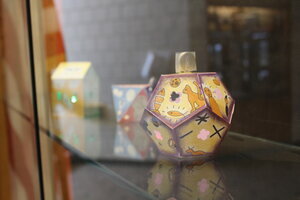
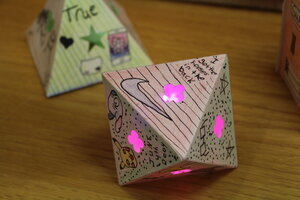
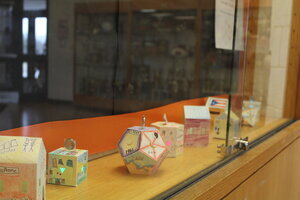

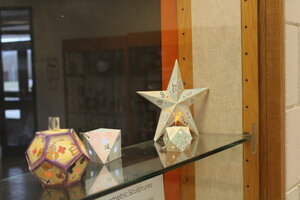


![IMG_0384[1].jpg](https://images.squarespace-cdn.com/content/v1/54a08126e4b038053fec29c3/1525981386025-ZPOUIDUGAPYWFGF3X3HC/IMG_0384%5B1%5D.jpg)





![IMG_0388[1].jpg](https://images.squarespace-cdn.com/content/v1/54a08126e4b038053fec29c3/1525981679008-QIZKQZNZ8PWUOD4P1U66/IMG_0388%5B1%5D.jpg)






















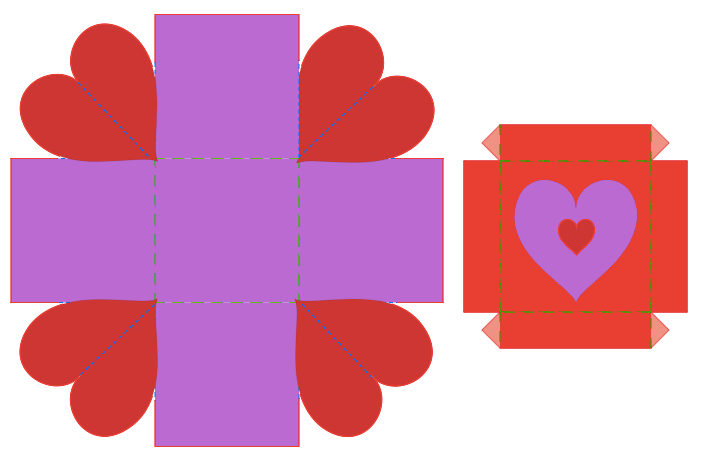














![TurkeyMaskDesign2 [Crop].png](https://images.squarespace-cdn.com/content/v1/54a08126e4b038053fec29c3/1510764141186-K1BYIFV1WQ0JEX3KL380/TurkeyMaskDesign2+%5BCrop%5D.png)
![TurkeyMaskDesign3[Crop].png](https://images.squarespace-cdn.com/content/v1/54a08126e4b038053fec29c3/1510764951816-5PW0RJE3BG780TIR7M0B/TurkeyMaskDesign3%5BCrop%5D.png)
![TurkeyMaskDesign4[Crop].png](https://images.squarespace-cdn.com/content/v1/54a08126e4b038053fec29c3/1510764979993-0IHBD24T1X4L0AZHLV5N/TurkeyMaskDesign4%5BCrop%5D.png)


